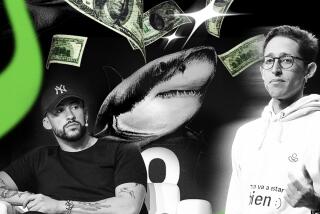Making the Grade and Getting a Start at Own Business
The judges all agreed they faced a difficult task in choosing a winner among the five San Diego State University students competing in the fourth annual Business Plan Competition last week.
They had to choose from five Entrepreneurial Management Center students, ranging in age from 23 to 45, each of whom had turned the germ of an innovative idea into a solid business plan, complete with logos, market analysis reports, financial plans and advertising proposals.
For their oral presentations last Friday, all five contestants highlighted their remarks with sophisticated audiovisuals created on an Apple computer and projected on an overhead screen for the benefit of the 50 students, advisers and business school adminstrators.
But the judgesâ decision finally rested on what, in the reality of the business world, is the most important criterion for obtaining financing for a start-up company: the quality and credibility of the management team.
Thomas Gilroy, a 45-year-old genetic engineer who left his job last year to pursue a longstanding dream to start his own business, clearly had the right stuff to win the competition. His idea for Genetic Enterprise, a DNA testing laboratory, was chosen by the judges even though Gilroyâs business plan was not the best-written and his oral presentation not the most articulate.
Gilroyâs plan was âone that the five of us were thinking we would want to invest in right away,â said Bent Peterson, managing partner of Coopers & Lybrand, who sat as one of five judges in the annual competition. Coopers & Lybrand also provided the $1,000 first-place and $500 second-place awards.
Gilroy beat out Kid-Stop, a drop-in child-care center for shopping malls; AirCare Products, a skin moisturizer for male airplane travelers; Air Net, a commuter network for traveling executives, and Paper Chase Recycling, a pickup recycling service for businesses generating computer paper waste.
Like the competing business plans, Genetic Enterprise was conceived as a start-up business that would give investors about a 10% annual return on their money over a five-year period. But, unlike some of the competitors, Genetic Enterprise was a serious business plan, not just an academic exercise to complete a course.
The only technologically oriented company in the competition, Gilroy said Genetic Enterprise would need $600,000 in start-up funds to establish a genetic testing laboratory. There, technicians would analyze genetic material (DNA) to help identify criminal suspects and settle paternity suits. Lawyers, law enforcement agencies and men facing paternity suits would be the companyâs main clients, Gilroy said.
Laboratory technicians would use existing technology for its tests in the companyâs first two years while scientists on the company payroll would work on developing a more sensitive and accurate genetic probe. That scheme would ensure Genetic Enterprise a prominent place in the new, but rapidly expanding market for genetic testing. According to Gilroyâs research, commercial DNA tests were used in about 3,000 legal cases last year, or double that of the year before.
Gilroy predicted that his company would lose money the first year, generating only $205,000 in revenues, but start turning a profit the following year. By its fifth year, the company should be pulling in about $5 million in revenue, Gilroy said.
âI learned a little more about issues involved in marketing--using advertising instead of pushing with salesmen,â Gilroy said of the judgeâs questions and remarks. âI also think you learn something from presenting your ideas to a group, just seeing peopleâs views about the prospects of getting a new business started.â
San Diego State Universityâs business school was one of the first in the country to create a center devoted to entrepreneurship. The center, founded in 1970, numbers among its graduates at least one mega-success story: James Sweeney, founder of Caremark, a home health-care services company based in Newport Beach that was sold in 1987 to Baxter International for more than $550 million. Sweeney was a judge in last weekâs competition.
Business school administrators used to believe entrepreneurship could not be taught, that luck or personal magnetism was the key ingredient, said Daryl Mitton, director of San Diego State Universityâs Entrepreneurial Management Center. That attitude kept courses in entrepreneurship out of the standard business school curriculum for years.
But, Mitton said, that approach began to change several years ago when serious thinkers began analyzing what goes into the making of an entrepreneur.
To enter the business plan competition, students must be enrolled in the course âVenture Management,â taught by Professor Alan Grant, a venture capitalist behind the creation of about 23 companies, including 10 started by former students. Students in his class form small working groups to conceive and write a business plan for the final term paper. A class vote then determines which five plans are submitted to the competition. Gilroy, the first-place winner, was the only contestant who worked on his plan alone.
Venture capitalists will take the time to look through only 10 of every 100 business plans submitted to them, Grant tells his students. Only one or two of those actually receive any funding. But the hardest lesson they have to learn is how to document and describe their costs in a thorough financial plan, he said.
âThatâs why the failure rate in new businesses is so high,â Grant said. âPeople say, âIâve got a great idea,â but then they underestimate how much cash theyâre going to need.â
That is precisely why business plan competitions are important, said patent lawyer Bill Bunker, a judge. Competitions âgive people real insight into the real world,â Bunker said. âLetâs face it. Itâs a jungle out there. If you have a real idea and are trying to get if off the ground, you need money. A strong business plan and oral presentation are the tools to getting it.â
Students who go through exercises requiring them to speak in front of people about their business ideas are more prepared for what happens when theyâre forced to address potential investors in the real world, Bunker said. In the past, there were no courses a would-be entrepreneur could take. âYou had to learn through the school of hard knocks,â he said.
Clutching the oversized check awarded at the end of the luncheon, Gilroy lost no time deciding how heâd spend his award. âI know Iâll invest it somehow to get the new company going,â he said. âNow Iâm a little more confident the company will actually start.â
In second place was Paper Chase Recycling Corp. The founder, Dawn Bell, a 29-year-old office manager and business school graduate, will split the $500 second-place prize money with members of her classroom management team.
The class and business plan competition taught the Clairemont woman âhow risky starting a business is. In your dreams, it works. But in reality, recycling is a tough industry.â
Of the three other competitors who received bronze plaques, only two said they plan to pursue their dreams despite being passed over by the judges:
Steven R. Lundgren, 40, a former PSA flight coordinator and business school student, said the judgesâ comments prompted him to reevaluate how he will market and price his commuter network service. And former flight attendant and business student Georgette Karavas, 29, said she remained determined to bring her product, AirCare, to the market one day.
Only Beverly Palm, 23, who along with two classmates conceived of Kid-Stop, said she had no illusions about the prospects of actually starting her own business.
Gilroyâs victory qualifies him for the universityâs first scheduled regional competition in late April, which will grant first-place winners $5,000.
âItâs his seed money,â Grant, his professor, smiled. âYouâve got to start somewhere.â
More to Read
Inside the business of entertainment
The Wide Shot brings you news, analysis and insights on everything from streaming wars to production â and what it all means for the future.
You may occasionally receive promotional content from the Los Angeles Times.










